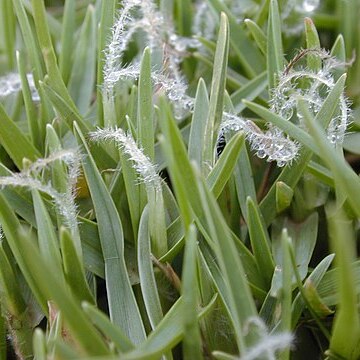Perennial, low, sward forming with slender rhizomes and extensive, stouter, much branched stolons. Vegetative shoots up to 20 cm tall, flowering shoots compact, 2–4 cm tall. Leaf sheaths loose, imbricate, subinflated; leaf blades linear, up to 15 × 0.2–0.5 cm on vegetative shoots, 1–4 cm on flowering shoots; ligule ca. 1.2 mm. Inflorescence reduced to 2–4 spikelets enclosed within the uppermost leaf sheath, only spikelet tips protruding; bristles very delicate, 1/2–3/4 as long as spikelet, scaberulous to ciliolate. Spikelets linear-lanceolate, 13–20 mm, acuminate; lower glume absent; upper glume cufflike, 1–3 mm or sometimes absent; lower floret neuter, lower lemma as long as spikelet, 10–13-veined, palea absent; upper lemma similar; anthers long exserted on threadlike filaments up to 5 cm; stigma simple or shortly bifid, up to 3 cm. Fl. and fr. summer–autumn. 2n = 36.
Perennial, 0.03-1.20 m high; creeps vigorously by rhizomes and stolons; culms closely sheathed, with abundance of bright green leaves. Leaf blade 50-300 x 3-7 mm, flat or folded, spreading; ligule a fringe of hairs. Inflorescence hidden, enclosed in uppermost leaf sheath, axis glabrous; filamentous stigmas and stamens with long filaments are clearly visible at flowering time; spikelet cluster sessile or nearly so; bristles delicate, scaberulous to ciliolate. Spikelet 10-20 mm long; glumes unequal; lower glume absent, upper glume 1-3 mm long, sometimes suppressed, glabrous. Florets 2; lower floret male or sterile, lemma as long as spikelet, tapering, without palea, glabrous; upper floret bisexual, lemma membranous to thinly coriaceous; anther 5.5-6.0 mm long and silvery, apical tufts of hairs absent. Flowering time Aug.-Apr.
Sward-forming perennial, with slender rhizomes, and stout rampant stolons amply clothed with pale subinflated leaf-sheaths; culms 3–15(–45) cm. high.. Leaf-blades 1–15 cm. long, 1–5 mm. wide, flat or folded.. Inflorescence reduced to a cluster of (1–)2–4(–6) subsessile spikelets concealed within the uppermost sheath; involucre sparse; bristles delicate, 1/3–3/4 the length of the spikelet, scaberulous to ciliolate.. Spikelets narrowly lanceolate, 10–20 mm. long; lower glume 0; upper glume ovate, 1–3 mm. long, rarely longer, sometimes suppressed; lower lemma narrowly lanceolate, as long as the spikelet, tapering, barren without a palea; upper lemma resembling the lower; stigma simple or shortly bifid, up to 3 cm. long, subplumose; anthers exserted on fine silvery filaments up to 5 cm. long.
Perennial 30-1 200 mm high; creeps vigorously by rhizomes and stolons; culms closely sheathed; leaves bright green and abundant. Leaf blade 10-300 x 1-7 mm; flat, spreading; ligule a fringe of hairs. Inflorescence of (1)2-4(-6) hidden spikelets enclosed in uppermost leaf sheath; filamentous stigmas and stamens with long filaments clearly visible at flowering time; spikelet clusters subsessile; bristles delicate, scaberulous to hairy. Spikelet 10-20 mm long; lower glume absent, upper glume 1-3 mm long, sometimes suppressed, glabrous; lower lemma as long as spikelet, tapering; palea absent; anthers 5.5-6.0 mm long, silvery, apical tufts of hairs absent.
Perennial, rhizomatous and stoloniferous, up to 1.2 m high, creeping vigorously by rhizomes and stolons. Leaf blades 50-300 mm long, 3-7 mm wide. Culms closely sheathed, with abundance of bright green leaves. Spikelets 10-20 mm long. Inflorescence partly enclosed in uppermost leaf sheath; filamentous stigmas and stamens with long filaments clearly visible at flowering time.
Inflorescence reduced to a cluster of (1)2–4(6) subsessile spikelets concealed within the uppermost sheath; involucre sparse; bristles delicate, 1/3–3/4 length of spikelet, scaberulous to ciliolate.
Rhizomatous, mat-forming perennial, sometimes to 30 cm. Leaves linear-oblong. Spikelets 10-20 mm long, enclosed in an upper leaf sheath.
Sward-forming perennial with slender rhizomes, and stout rampant stolons amply clothed with pale sub-inflated leaf-sheaths.
The silvery filaments of the stamens are conspicuously exserted from the leaf-sheath when in flower.
Inferior glume absent; superior 1–3 mm. long, sometimes suppressed.
Anthers exserted on fine silvery filaments up to 5 cm. long.
A creeping perennial with stout stolons forming a dense mat
Leaf laminae 1–15 cm. long, flat or folded.
Stigma up to 3 cm. long, subplumose.
Superior lemma resembling inferior.
Inferior lemma as long as spikelet.
Spikelets 10–20 mm. long.
Culms 3–15(45) cm. high.

